Randy Krum's Blog
October 29, 2025
Scorigami: Visualize Every NFL Score Ever
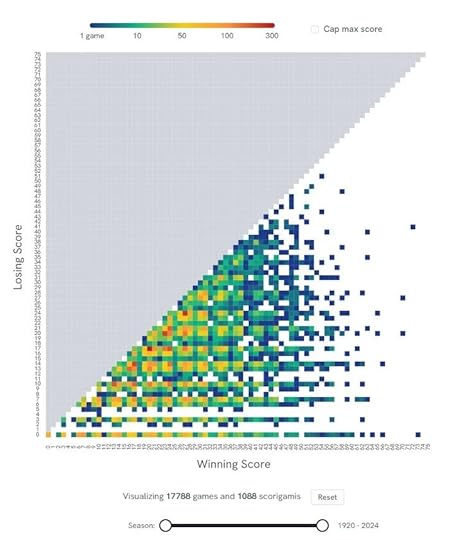
Scorigami: Visualize Every NFL Score Ever is a fun interactive infographic were you can see every final NFL score in history and how often each score occurs. PerThirtySix took the inspiration from Jon Bois coined term “scorigami” and is updated weekly.
You can view all team or use the controls to narrow down the visualization to just the teams and years you want to see. It’s fun to play with.
A scorigami is a final score that has never happened before in the history of the NFL. The term was coined by Jon Bois and narrated in a 2017 video called Every NFL Score Ever (highly recommended, Jon Bois is one of best storytellers out there!). Since then, scorigami has entered the football lexicon and has become a fun way to track the history of the NFL.
Found on PerThirtySix
October 14, 2025
The State of the Space Program infographics
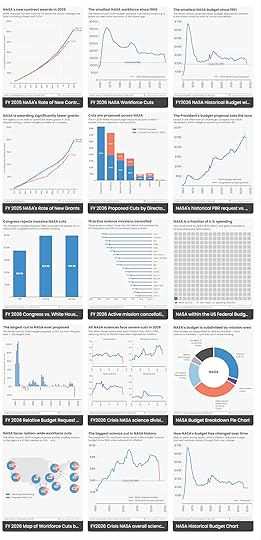
The Planetary Society has a great collection of infographics and data visualizations about NASA and the U.S. Space Program.
Founded in 1980 by Carl Sagan, Louis Friedman, and Bruce Murray, The Planetary Society is the world’s largest and most influential non-profit space organization. With a global community of more than 2 million space enthusiasts, they promote their mission to “Empower the world’s citizens to advance space science and exploration.”
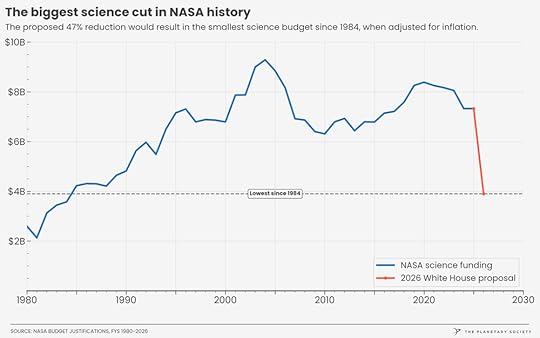
October 6, 2025
Pirated DataViz Books Used to Train AI

For all of my fellow book authors, you can now positively determine if pirated copies of your book(s) were illegally used in the training of AI models. Use the search tool here: https://secure.anthropiccopyrightsettlement.com/lookup
Doing a quick check, I confirmed that the Cool Infographics book is included, as well as many of the other data visualization and infographics books that I have in my library. A quick check of many other popular dataviz authors confirms that pirated books by Alberto Cairo, Steve Wexler, Cole Nussbaumer Knaflic, Nathan Yau, Edward Tufte, Stephen Few, Garr Reynolds, Jonathan Schwabish, RJ Andrews, Manuel Lima, Andy Kirk, Noah Iliinsky, Scott Berinato, Ben Jones, Naomi Robbins, and David McCandless are all included in the training database.
The double-edged sword is that the inclusion of these books makes the AI models really good at giving advice about data visualizations, charts, and infographics. The models learned from the best. The downside is no compensation or credit is given to any of these authors who spent years of work building their knowledge and writing comprehensive books.
As part of the class action Anthropic Settlement from Bartz v. Anthropic in September 2025, an online searchable Works List of all books included in the lawsuit is now available. Authors can search the database to positively determine which of their book(s) were used to train the Anthropic models. Of course, not just dataviz books, but thousands of fiction and non-fiction books.
Historically, there hasn’t been an absolute list of pirated books used to train the major AI platforms. Allegedly, the BOOKS3 and LIBGEN databases online were lists of pirated books used by chatGPT, Meta and others to train their AI models. However, there was never any official confirmation by any of the AI companies about which specific pirated books they used.
This new development from the Anthropic settlement, is that they have made public a searchable database of the books covered under the lawsuit that were used in the training of their AI models. The lawsuit settlement forced them to be specific about which books were used. Although the search tool is convenient, it falls short of actually publishing the full list.
As an author, if you wish to be included in the settlement, you can file a claim on the settlement website: https://www.anthropiccopyrightsettlement.com
September 15, 2025
Planets Mean Temperatures

Planets Mean Temperatures made by Jonathan Chris uses a box and whisker plot to show the average surface or atmosphere temperature of a planet in Celsius or Fahrenheit. A cool way to use the normal layout of the solar system graphic, but with the twist that they are rearranged by mean temperatures instead.
Explore the mean temperatures of planets. The mean temperature of planets refers to the average surface or atmospheric temperature of a planet over a specific period of time. This measure provides a general indication of the thermal environment of the planet and is typically calculated by averaging temperature readings taken at various locations and times on the planet’s surface or atmosphere.
I love this simple visualization, and the use of the actual planet images on the chart instead of dots and text.
Found on Tableau Public Viz of the Day
August 21, 2025
Photography Cheat Sheet

Emanuel Caristi starts his photography tutorial on shooting in manual mode, with a Photography Cheat Sheet.
Shooting in manual mode is nothing mystical or for which you should be afraid, especially if you are not under pressure and you have time to meditate on your settings. Learning these simple technical knowledge will give you the photography fundaments, necessary to be confident with your camera and to taking control of the action.
All you need to know to start to take well-exposed pictures is how Aperture, Shutter speed, and ISO affect your photos.
I really simplified certain concepts to make them easier to digest, my wish is you get the basic tools to be more active taking photos. If you have not a DSLR or Mirrorless, you can certainly use your smartphone, its camera surely can be used in manual mode.
The visual example of each setting is incredibly helpful.
See full post at emanuelcaristi.com
May 20, 2025
Power Tool Manufacturers and Who Really Owns Them-2024

Power Tool Manufacturers and Who Really Owns Them-2024 infographic, provides a nice snapshot view of which companies own which tool brands (and it’s been changing rapidly in the last few years). You can read the full article on ProTool Reviews or watch Clint DeBoer’s YouTube video.
In a time when companies are gobbling up companies as fast as teenagers devour pizza, the landscape of business is rapidly changing, with mergers and acquisitions becoming the norm. It’s often hard to know who owns which tool brands anymore. Don’t worry, I’ve got you. If you’ve ever wondered who owns Craftsman Tools, Milwaukee Tool, Mac Tools, Skil, or any other major tool manufacturing brand, this article should answer most of your questions. It may surprise you to know that just a handful of power tool companies own your favorite tools. That’s right; most tool brands fall under a parent company that also owns additional power tool manufacturers and brands. I’ll break it all down for you. Prepare for lots of lists!
I appreciate that the infographic is a summary overview of a detailed article and video that walks through the highlights in detail.
Infographic from ProTool Reviews.
March 25, 2025
How Long Do Animals Live?
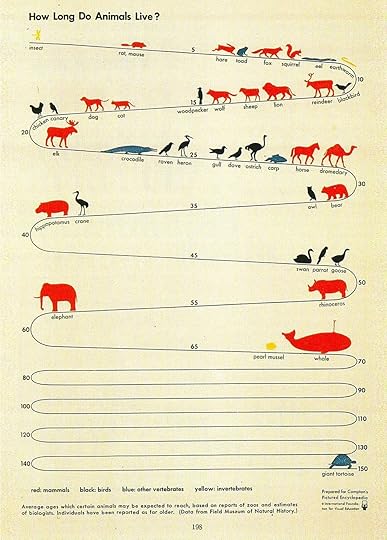
How Long Do Animals Live? is from Compton’s Pictured Encyclopedia from 1943a, depicting the life expectancy of mammals, birds, other vertebrates, and invertebrates. The zig zag style really helps to condense the long timeline into a condensed infographic.
I’m generally not a fan of winding timeline designs, but this one works for me. The visual metaphor of the animals walking down a path really works. From 1939!
Shared on RJ Andrew’s Substack
January 16, 2025
2024 US Presidential Election Eclipse

The 2024 US Presidential Election Eclipse infographic. A cool way to use a Dorling cartogram. You still have the general shape of the US, but sizing is representative of the number of total votes casts. Then the additional use of a “solar eclipse” look to visualize the votes for the winning party. Created by Kenneth Field with ArcGIS. Make sure to check out the hi-rez copy.
This map portrays the US states as a Dorling cartogram with each state shown as a circular symbol proportional to the total votes cast. It illustrates not only the winner in each state, but also a number of additional metrics using moonpie symbols that show the percentage obscuration caused by the winning party (akin to a solar eclipse). Whether they won or lost, Democrats are on the left of the symbols and Republicans on the right.
Professionally, I’m fascinated with election maps. As a designer and critic in the data visualization community, I don’t think anyone has really gotten this design challenge right…yet.
I really like this design because it shows the impact of both party’s votes in each state. Too many of the usual designs only show the winning party, but the Dorling design does a good job of showing both the winning and losing party votes in each state. I also appreciate the subtle left/right placement of the party votes in each state.
Found on Bluesky. Thanks to Steve Wexler for sharing!
December 26, 2024
Support these Data Visualization Organizations

As the year comes to a close, you may be considering some last-minute charitable donations. You may not realize that a number of tools and organizations within the data visualization community are supported by donations and need your help. Here are four data visualization tools and organizations that are donation-funded.
Processing FoundationProcessing Foundation is the non-profit organization behind Processing, p5.js, and the p5.js Editor. Every year, they support over a million creative coders of all ages around the world through software development and public programs.
100% of your donation will support software development and maintenance.
RAWgraphsRAWGraphs is an open source data visualization framework built with the goal of making the visual representation of complex data easy for everyone.
Primarily conceived as a tool for designers and vis geeks, RAWGraphs aims at providing a missing link between spreadsheet applications (e.g. Microsoft Excel, Apple Numbers, OpenRefine) and vector graphics editors
Data Visualization SocietyThe Data Visualization Society fosters a community where every member benefits from resources that support growth, refinement, and expansion of data visualization knowledge regardless of expertise level.
Their mission is to invest in communication platforms and events to connect members, education platforms for teaching and learning, and leveraging those resources to foster skills growth, knowledge exchange, and meaningful critique.
Viz for Social GoodNon-profits around the world are driving positive social change, but many of them lack the in-house resources to effectively tell their story with the data they have.
Viz for Social Good helps non-profits thrive in the digital age by connecting them with talented data visualization enthusiasts in collaborative projects. The impactful visuals created by our volunteers have helped our partners raise awareness of their causes, advocate for their initiatives in front of important stakeholders, aid in fundraising efforts critical to their operations, and make data-driven decisions.
October 11, 2024
How Long Can People Cover Their Needs Without Income?
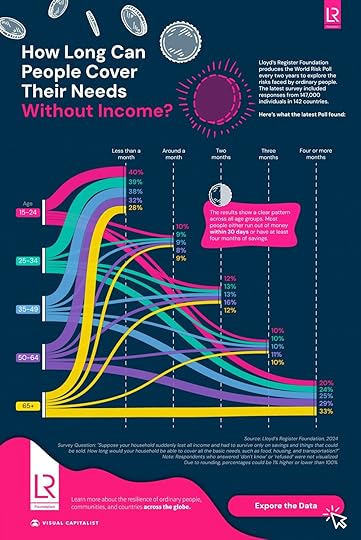
How Long Can People Cover Their Needs Without Income? infographic by Visual Capitalist.
How Long Can People Cover Their Needs Without Income?With nearly half of people under 34 worldwide unable to cover their needs for a month or less without income, it is no surprise that financial resiliency is a hot topic.
So, for this graphic, Visual Capitalist has partnered with Lloyd’s Register Foundation to explore economic resilience further and determine how long the average person can afford to cover their needs without income.
World Risk Poll 2024 Report: Economic ResilienceLloyd’s Register Foundation produces the World Risk Poll every two years in partnership with Gallup, and the World Risk Poll 2024 report explores the everyday risks of 147,000 people from 142 nations.
They asked respondents how long they could afford to cover basic needs, such as food, transport, and shelter, if they lost all income.
The results reveal a distinct trend across all age groups, with respondents typically falling into two categories: those with one month or less of financial runway, and those with more than four months. Relatively fewer respondents reported being able to survive two to three months.
I think this is a really interesting adaptation of a Sankey/Alluvial diagram. I’d like to see summaries of each timeframe to support their discussion around trends.
Found on Visual Capitalist.



